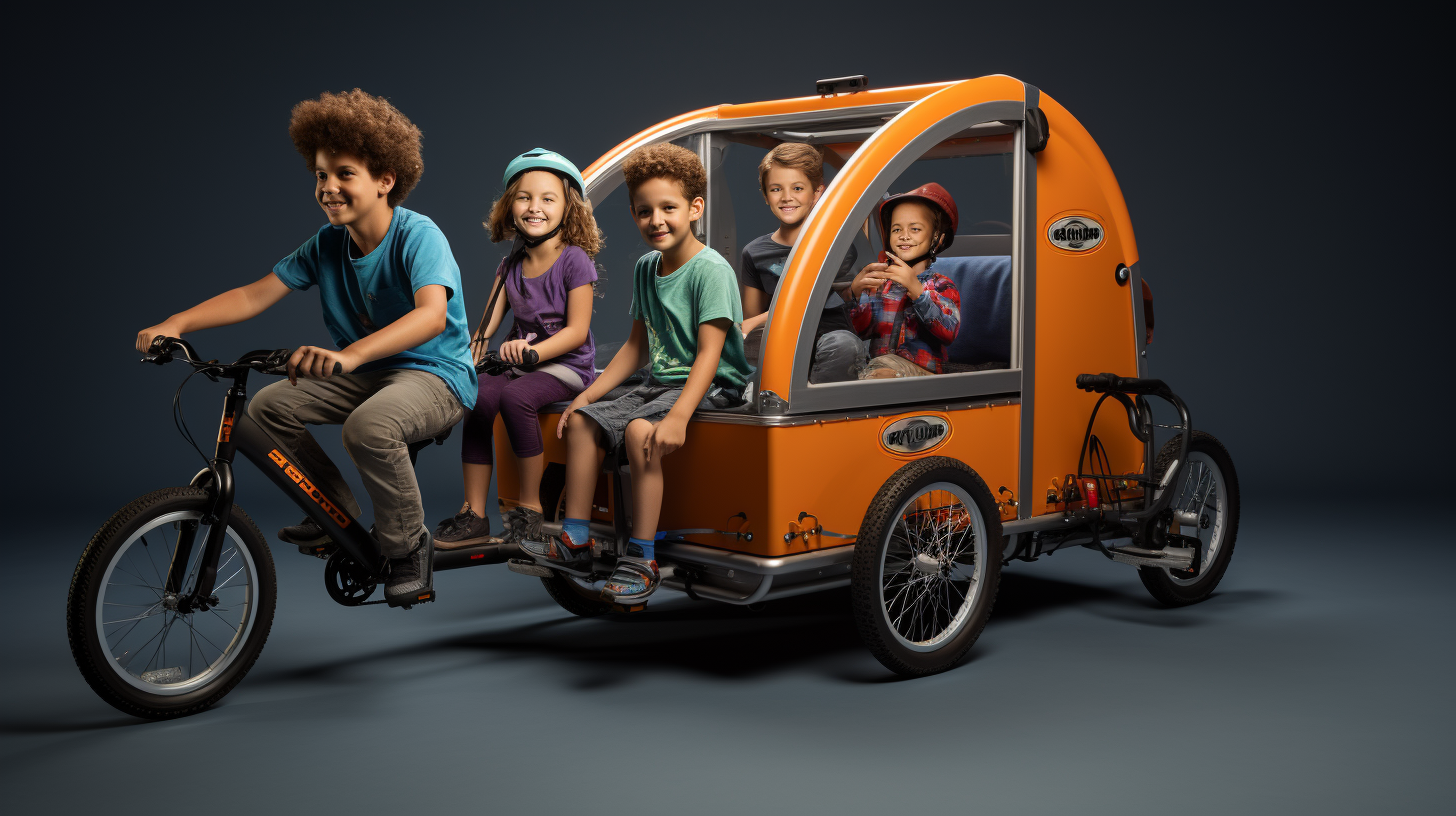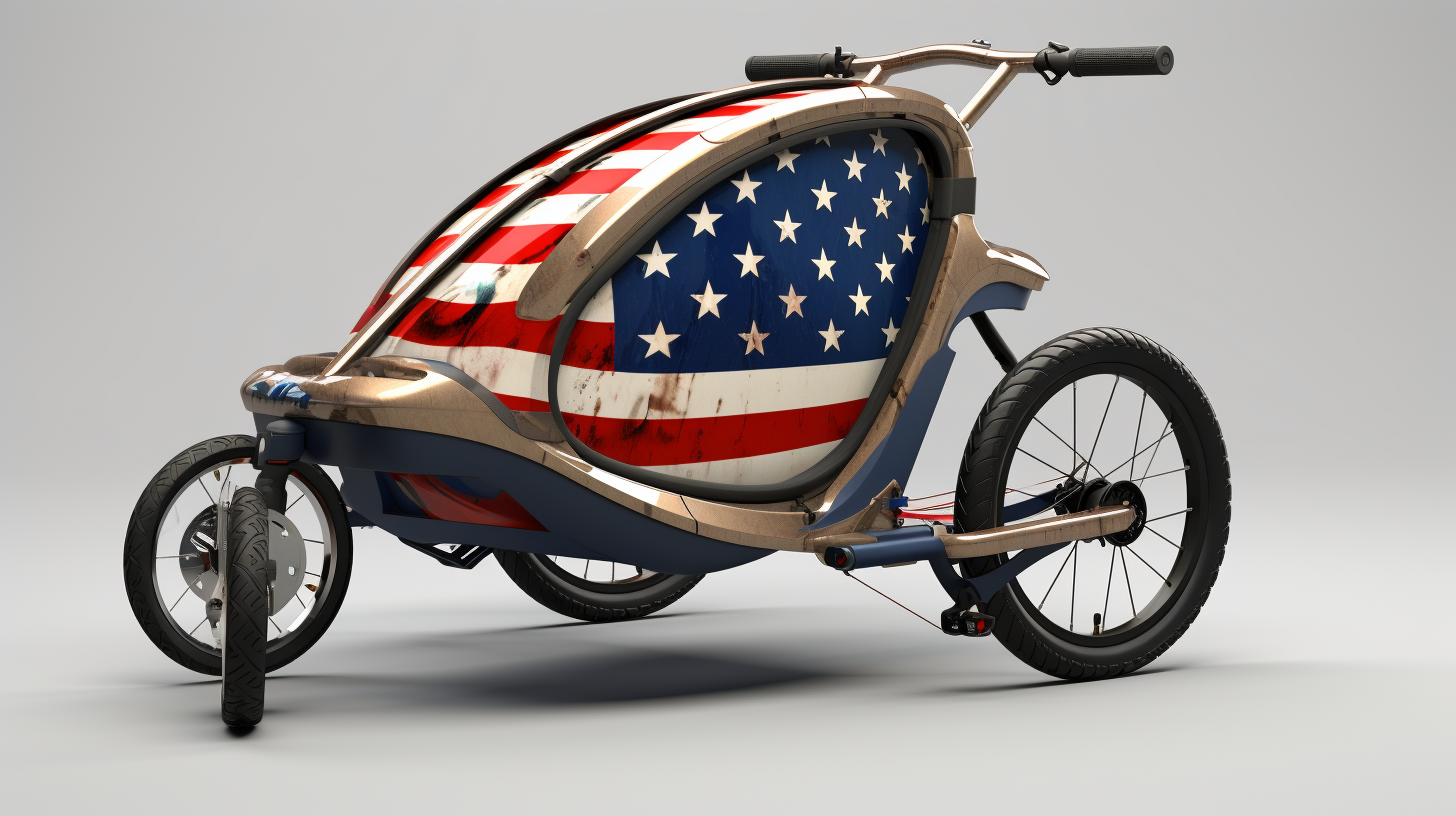As a parent who is passionate about biking, I have frequently pondered the safety of bike trailers. Are they strong enough to safeguard our valuable cargo? Do they possess the essential safety elements to ensure the security of our children?
In this article, we’ll delve into the design and construction of bike trailers, explore the essential safety features to look for, and discuss important considerations and precautions to ensure a secure connection between bike and trailer.
Join me as we uncover the truth behind bike trailer safety and make informed decisions for our family’s cycling adventures.
Key Takeaways
- Sturdy frame and secure attachment system ensure stability
- Safety harness and seat belts keep children secure during the ride
- Reflective materials enhance visibility, especially in low-light conditions
- Proper installation and attachment distribute weight evenly and ensure a balanced and safe riding experience
Understanding the Design and Construction of Bike Trailers
To understand the design and construction of bike trailers, you’ll need to consider factors like weight capacity and frame materials. Bike trailers come in different weight limits, ranging from 50 pounds to over 100 pounds. It’s important to choose a trailer that can safely accommodate both your child and any additional items you plan to carry.
In terms of frame materials, most bike trailers are made of either aluminum or steel. Aluminum frames are lightweight and resistant to rust, while steel frames offer durability and stability.
When it comes to storage options, bike trailers usually have a spacious interior where you can place your belongings. Some models even come with additional storage pockets or compartments, allowing you to keep items organized and easily accessible during your ride. It’s also worth considering whether the trailer can be easily folded or disassembled for storage when not in use.
Now that we’ve discussed the design and construction of bike trailers, let’s move on to the safety features to look for.
Safety Features to Look for in a Bike Trailer
When it comes to choosing a bike trailer, safety should be a top priority. There are several key features to consider, including a sturdy frame and secure attachment system. These features ensure that the trailer remains stable and securely attached to the bike, even on rough terrain.
Additionally, a safety harness and seat belts are essential for keeping your child secure and protected during the ride. Reflective materials and visibility enhancements are also important for increasing visibility, especially when riding in low light conditions.
Sturdy Frame and Secure Attachment System
The bike trailer’s frame is sturdy and the attachment system is secure, ensuring safety while riding. Understanding bike trailer weight limits is crucial for maintaining a safe and enjoyable experience. Each trailer has a specific weight limit that should not be exceeded. Exceeding this limit can affect the trailer’s stability, compromising the safety of both the rider and the passengers.
Proper installation and attachment are also important factors to consider. The trailer should be securely attached to the bike, following the manufacturer’s instructions. This ensures that the trailer remains stable and does not detach during the ride. Additionally, proper installation helps distribute the weight evenly, providing a balanced and safe riding experience.
Now, let’s move on to the next section, which focuses on the safety harness and seat belts.
Safety Harness and Seat Belts
Make sure you properly fasten your seat belts and secure the safety harness for a safe and comfortable ride. Proper installation of safety harnesses and seat belts is of utmost importance when it comes to ensuring the safety of passengers in bike trailers.
These restraints are designed to keep riders securely in place and prevent them from being thrown out of the trailer in case of an accident or sudden stop. Manufacturers conduct rigorous testing to ensure the durability and effectiveness of these safety features. They subject them to various stress tests, including pulling, twisting, and impact tests, to evaluate their strength and ability to withstand different scenarios. This ensures that the safety harnesses and seat belts can withstand the forces exerted during normal use and offer maximum protection to the riders.
As we move on to the next section about reflective materials and visibility enhancements, it is important to consider how these additions further enhance the safety of bike trailers.
Reflective Materials and Visibility Enhancements
Using reflective materials and visibility enhancements is crucial to increasing the safety of riders in bike trailers. When it comes to bike trailer visibility, here are three important factors to consider:
-
Reflective materials: Incorporating reflective strips or tape on the trailer’s exterior can significantly improve visibility, especially in low-light conditions. These materials bounce back light when illuminated, making the trailer more visible to motorists and other cyclists.
-
Bright colors: Opting for bright colors like neon yellow or orange can also enhance visibility during daytime rides. These vibrant colors catch the attention of others on the road, reducing the risk of accidents.
-
LED lights: Installing LED lights on the rear of the trailer further enhances visibility, particularly at night. These lights emit a bright, steady or flashing light and can be easily seen from a distance, ensuring the safety of riders and their passengers.
By incorporating these reflective materials and visibility enhancements, riders can significantly improve their safety on the road.
Transitioning into the subsequent section about considerations for riding with children in bike trailers, it is important to address other aspects of ensuring a safe and enjoyable experience.
Considerations for Riding with Children in Bike Trailers
When riding with children in bike trailers, it is crucial for their safety that they are properly secured and wearing helmets.
First and foremost, you need to ensure a secure attachment between the trailer and your bike. This can be achieved by using a reliable hitch system that securely connects the trailer to the bike frame. It is important to regularly check the hitch for any signs of wear or damage to ensure it remains secure throughout your ride.
Additionally, visibility enhancements are essential to make your presence known on the road. Many bike trailers come with reflective materials and bright colors to improve visibility. You can further enhance visibility by attaching additional reflective accessories, such as lights or tape, to the trailer. These will help motorists see you and your children, especially during low light conditions.
Now that we have covered the importance of securing the children and enhancing visibility, let’s explore some tips for ensuring a secure connection between your bike and the trailer.
Tips for Ensuring a Secure Connection between Bike and Trailer
To ensure a secure connection between your bicycle and the trailer, you’ll want to regularly inspect the hitch for signs of wear or damage. The bike trailer attachment is crucial for maintaining the safety of your ride, as it is responsible for keeping the trailer securely attached to the bike. Over time, the hitch can experience wear and tear due to repeated use and exposure to the elements. By inspecting the hitch before each ride, you can identify any potential issues and address them promptly.
Start by checking the attachment point on your bike. Look for any signs of rust, corrosion, or loose bolts. Ensure that the hitch is properly aligned and tightened, as a loose connection can compromise stability and control. Inspect the trailer’s hitch as well, paying attention to any frayed or damaged straps or buckles. If you notice any issues, it’s important to replace or repair them before using the trailer.
Regular maintenance is key to keeping your bike trailer connection secure. Lubricate the hitch regularly to prevent rust and ensure smooth operation. Clean the hitch and remove any debris that may interfere with its functionality. By taking these simple steps, you can minimize the risk of accidents caused by a faulty bike trailer attachment.
Transitioning into the next section about potential risks and precautions to take with bike trailers, it’s important to be aware of the potential dangers that can arise when using a bike trailer.
Potential Risks and Precautions to Take with Bike Trailers
One important precaution to take with bike trailers is ensuring proper visibility by attaching reflective materials to the trailer. This is crucial to reduce the risk of potential accidents, especially when riding in low light conditions or at night. Reflective strips or stickers can be easily attached to the sides and rear of the trailer, making it more visible to motorists and pedestrians.
To further enhance safety when riding with pets in bike trailers, here are some tips to consider:
- Secure your pet properly inside the trailer using a harness or a leash attachment. This will prevent them from jumping out or moving around too much during the ride.
- Choose a trailer with a low center of gravity to minimize the risk of tipping over, especially when going around corners or over uneven terrain.
- Check the trailer’s tires regularly and ensure they are properly inflated. This will improve stability and handling, reducing the likelihood of accidents.
- Always ride at a safe and comfortable speed, taking into account the weight and size of the trailer, as well as the road conditions.
By following these precautions, you can greatly reduce the risk of accidents while riding with pets in bike trailers.
Now let’s move on to educating children on safe riding habits in bike trailers.
Educating Children on Safe Riding Habits in Bike Trailers
Educating children about proper riding habits in bike trailers is essential for their safety. Bike trailer accidents can occur if children are not taught the necessary safety precautions. Teaching children bike safety from a young age is crucial to ensure their well-being while riding in bike trailers.
One important aspect of educating children about bike trailer safety is teaching them to always wear a properly-fitted helmet. Helmets can greatly reduce the risk of head injuries in the event of a crash or fall. Additionally, children should be instructed to sit properly and securely in the bike trailer, with their feet placed firmly on the floor or footrests. This helps to maintain stability and balance during the ride.
It is also important to teach children about the importance of staying seated and not leaning out or reaching for objects while the bike trailer is in motion. These actions can cause the trailer to become unbalanced, leading to accidents. Furthermore, children should be educated on the need to hold onto the trailer’s safety straps or handles at all times.
By teaching children these safe riding habits, we can significantly reduce the risk of bike trailer accidents and injuries.
In the next section, we will discuss recommendations for choosing the right bike trailer for your family, ensuring both safety and comfort for your child.
Recommendations for Choosing the Right Bike Trailer for Your Family
When it comes to choosing the right bike trailer for your family, there are a few key points to consider.
First, you’ll want to think about the number of children you’ll be transporting and the weight capacity of the trailer. This will ensure that everyone is safe and comfortable during your rides.
Next, it’s important to evaluate the suspension and shock absorption of the trailer, as this will help provide a smooth and stable ride for your little ones.
Lastly, reading reviews and seeking recommendations from other parents can provide valuable insights and help you make an informed decision.
Considering the Number of Children and Weight Capacity
The weight capacity of bike trailers determines how many children can safely ride in them. It is important to consider the number of children you have when choosing a bike trailer, as exceeding the weight limit can compromise their safety. Here are some factors to consider when evaluating the weight capacity of a bike trailer:
-
Safety: Ensuring that the weight capacity of the trailer can handle the combined weight of your children will provide a safer riding experience.
-
Comfort: A bike trailer with a higher weight capacity will allow your children to sit comfortably without feeling cramped.
-
Durability: Choosing a bike trailer with a higher weight capacity ensures that it is built to handle the demands of carrying multiple children.
-
Long-term use: If you plan to use the trailer for multiple years or with multiple children, a higher weight capacity will provide more versatility.
-
Peace of mind: Knowing that the weight capacity of the trailer matches your needs will give you peace of mind while riding.
Considering the number of children and the weight capacity of a bike trailer is crucial for ensuring their safety and comfort. Once you have determined the appropriate weight capacity, the next step is to evaluate suspension and shock absorption.
Evaluating Suspension and Shock Absorption
To ensure a smooth and comfortable ride, you’ll want to evaluate the suspension and shock absorption of the bike trailer. When it comes to evaluating suspension, it’s important to consider how well the trailer handles bumps and uneven terrain. A good suspension system will help absorb the impact of rough roads, ensuring a smoother ride for your child.
The shock absorption is also crucial when it comes to your child’s comfort. A trailer with poor shock absorption can result in a bumpy and jarring ride, which can be uncomfortable for your little one. Additionally, inadequate suspension and shock absorption can pose potential risks, such as increased vibrations and impacts, which may affect the overall safety of the trailer. Therefore, it’s essential to carefully evaluate these features before making a purchase.
Considering the impact on your child’s comfort and the potential risks involved, it is important to thoroughly evaluate the suspension and shock absorption of any bike trailer you are considering. However, it can be difficult to determine the quality of these features just by looking at the product. This is why reading reviews and seeking recommendations from other parents can be incredibly helpful.
Reading Reviews and Seeking Recommendations
Reading reviews and seeking recommendations from other parents can provide valuable insight into the performance and reliability of different bike trailers.
As a parent, I understand the importance of making an informed decision when it comes to purchasing a bike trailer for my family. By reading reviews, I can gain a better understanding of the experiences and opinions of other parents who have already used a particular bike trailer. This allows me to compare prices, understand the features, and determine which option is the best fit for my family’s needs.
Additionally, seeking recommendations from other parents who have similar preferences and lifestyles can provide valuable guidance in making the right choice. Understanding the benefits of bike trailers for family cycling is crucial in ensuring a safe and enjoyable experience for everyone involved.
Understanding the Benefits of Bike Trailers for Family Cycling
Understanding the benefits of bike trailers for family cycling can help parents make an informed decision. Bike trailers are a fantastic way to enjoy outdoor activities with your children while also promoting a healthy lifestyle. These trailers are specifically designed to safely transport one or two children behind your bike. In addition to providing a safe and secure riding experience, bike trailers offer several other benefits.
One of the advantages of using a bike trailer is the availability of various accessories. Accessories such as weather shields, bug screens, and padded seating provide extra comfort and protection for your little ones. This ensures that they are shielded from the elements and remain comfortable throughout the ride.
Another benefit is the storage options that bike trailers offer. Many trailers come with built-in storage compartments where you can keep essential items such as snacks, water bottles, and extra clothing. This eliminates the need for additional bags or backpacks and allows you to have everything you need conveniently within reach.
Understanding these benefits can help parents make an informed decision when considering whether to invest in a bike trailer for family cycling. By having access to bike trailer accessories and storage options, parents can ensure a pleasant and enjoyable experience for their children.
Real-life stories and experiences from parents and cyclists further highlight the advantages of using bike trailers for family cycling.
Real-Life Stories and Experiences from Parents and Cyclists
After learning about the benefits of bike trailers for family cycling, I was eager to hear real-life stories and experiences from parents and cyclists. I wanted to know if these trailers were as safe and practical as they seemed. So, I reached out to fellow parents and scoured online forums to gather some insightful testimonials. Here’s what I discovered:
-
Safety First: The overwhelming majority of parents praised the safety features of bike trailers. They emphasized the sturdy construction, secure harnesses, and effective braking systems, which provided peace of mind while riding with their little ones.
-
Protection from the Elements: Many testimonials highlighted how bike trailers offered protection from wind, rain, and harmful UV rays. Parents appreciated the adjustable covers and mesh screens that shielded their children from the elements, ensuring a comfortable and enjoyable ride for everyone.
-
Enhanced Visibility: Numerous cyclists mentioned that bike trailers improved their visibility on the road. With bright colors, reflective strips, and attached flags, these trailers made them more noticeable to other drivers, reducing the risk of accidents.
-
Smooth Ride: Parents consistently raved about the smooth and stable ride that bike trailers provided. They praised the suspension systems, which absorbed bumps and vibrations, ensuring a comfortable journey for their little passengers.
Now that we’ve explored real-life testimonials and addressed safety concerns, it’s time to delve into a comparison of bike trailers with other child carrying options.
Comparing Bike Trailers to Other Child Carrying Options
Now let’s see how bike trailers stack up against other options for carrying your child.
When it comes to biking with your little one, there are a few choices available, including bike seats and strollers.
Let’s start by comparing bike trailers with bike seats.
Bike seats are mounted directly onto the bike, allowing your child to ride behind you. While they offer a more interactive experience and a closer bond between you and your child, they do have some limitations. Bike seats are generally suitable for children aged one to five years old, with a weight limit of around 40 pounds.
On the other hand, bike trailers can accommodate children of various ages, often up to 100 pounds. This makes them a more versatile option for growing families.
When it comes to comparing bike trailers with strollers, there are several advantages that bike trailers have over strollers.
Firstly, bike trailers allow you to actively engage in physical activity while spending time with your child. Additionally, they provide a smoother and more comfortable ride for your child, as they are designed to absorb shocks from uneven terrain. Furthermore, bike trailers offer more storage space for your belongings, making them convenient for longer trips.
Now that we’ve explored the comparison with other child carrying options, let’s move on to the next section and delve into the safety regulations and standards for bike trailers.
Safety Regulations and Standards for Bike Trailers
When it comes to using bike trailers, it’s important to be aware of the safety regulations and standards in place. One of the key aspects of ensuring the safety of bike trailers is to look for proper certifications.
Before purchasing a bike trailer, it is crucial to check if it meets the safety standards set by organizations such as the American Society for Testing and Materials (ASTM) and the Consumer Product Safety Commission (CPSC). These certifications ensure that the trailer has undergone rigorous testing to ensure its structural integrity and safety features.
In addition to checking for certifications, proper assembly of the bike trailer is essential for ensuring the safety of your child. Following the manufacturer’s instructions and guidelines for assembly is paramount. This includes securely attaching the hitch to your bicycle and ensuring that all components, such as the seatbelts and harnesses, are properly fastened and adjusted. Regularly inspecting the trailer for any signs of wear and tear, such as loose screws or frayed straps, is also important to maintain its safety.
As we delve into tips for properly loading and securing children in bike trailers, it is crucial to keep in mind the importance of adhering to these safety regulations and standards. By doing so, we can ensure a safe and enjoyable biking experience for both the parents and their children.
Tips for Properly Loading and Securing Children in Bike Trailers
To ensure the well-being of your child while riding in a bike trailer, make sure they are properly loaded and securely fastened.
When it comes to loading techniques, it is important to distribute the weight evenly in the trailer. Place heavier items closer to the center and lower to the ground to maintain stability. This will prevent the trailer from tipping over and provide a smoother ride for your child.
Additionally, make sure your child is comfortable by providing adequate padding and support. Use cushions or blankets to create a cozy and snug environment. Ensure that your child is wearing a properly fitted helmet at all times for added safety.
When it comes to securing your child in the bike trailer, follow the manufacturer’s instructions carefully. Most trailers have a harness system that keeps your child secure during the ride. Make sure the straps are tightened properly and that your child is snugly strapped in. Avoid loose clothing or items that could potentially get caught in the wheels or spokes.
In conclusion, loading techniques and child comfort are crucial factors when using a bike trailer. By following these tips, you can ensure that your child has a safe and enjoyable ride.
Now let’s move on to maintenance and care tips for bike trailers.
Maintenance and Care Tips for Bike Trailers
Taking proper care of your child’s bike trailer is essential to ensure its longevity and optimal performance. Here are some maintenance and care tips for your bike trailer:
-
Regularly clean the trailer: Use a mild soap and water solution to clean the trailer’s frame, fabric, and any other parts. Avoid using harsh chemicals that may damage the materials.
-
Check for wear and tear: Inspect the trailer regularly for any signs of wear and tear, such as loose screws, frayed straps, or damaged wheels. Replace or repair any damaged parts promptly.
-
Lubricate moving parts: Apply lubricant to the bike trailer’s moving parts, such as the wheel axles and hitch connections, to ensure smooth operation.
-
Store properly: When not in use, store the bike trailer in a clean, dry place. Avoid leaving it exposed to harsh weather conditions, which can cause damage over time.
-
Troubleshoot common issues: If you encounter any issues with your bike trailer, such as a wobbly hitch or difficulty folding, consult the manufacturer’s instructions or contact customer support for assistance.
By following these maintenance and care tips, you can ensure that your child’s bike trailer remains in good condition and provides safe and enjoyable rides.
Now, let’s move on to frequently asked questions about bike trailer safety.
Frequently Asked Questions About Bike Trailer Safety
Make sure you are aware of the recommended weight limit for your child’s bike trailer. When it comes to bike trailer safety, one of the most important factors to consider is the weight capacity of the trailer. Exceeding this limit can compromise the stability and control of the trailer, increasing the risk of accidents. It’s important to note that weight limits can vary depending on the specific model and brand, so always refer to the manufacturer’s guidelines.
In addition to adhering to weight limits, it is crucial to use proper riding techniques when pulling a bike trailer. This includes maintaining a safe speed, especially when going downhill or around corners. Slow down and take extra caution to prevent potential accidents. It is also important to be mindful of the trailer’s width, as it can affect maneuverability in tight spaces.
When it comes to potential accidents, it’s important to be prepared for the unexpected. Always wear a helmet when cycling with a bike trailer, both for yourself and your child. Ensure that the trailer is properly attached to your bike, with all the necessary safety features in place.
Conclusion: Making an Informed Decision for Your Family’s Cycling Adventures
After reviewing the frequently asked questions about bike trailer safety, I feel confident in making an informed decision for my family’s cycling adventures. The importance of research cannot be overstated when it comes to the safety of our loved ones.
When making decisions about bike trailers, it is crucial to consider various factors. Firstly, always ensure that the trailer meets safety standards and regulations. Look for trailers that have been tested and certified by reputable organizations like the American Society for Testing and Materials (ASTM). These certifications guarantee that the trailer has undergone rigorous testing and meets the necessary safety requirements.
Secondly, consider the trailer’s design and features. Look for trailers with a low center of gravity and a stable base to prevent tipping. Also, check for proper harness systems and sturdy frames that can withstand impact. Additionally, consider trailers with additional safety features such as reflective materials and flag mounts to enhance visibility.
Lastly, read reviews and seek recommendations from other parents or cycling enthusiasts. Their experiences can provide valuable insights into the overall performance and safety of different bike trailers.
Frequently Asked Questions
Are bike trailers suitable for all ages of children?
Bike trailers offer numerous benefits for children of all ages. They provide a safe and secure way to transport kids while enjoying outdoor activities. Benefits include improved physical activity, enhanced family bonding, and the opportunity to explore the surroundings.
However, there are a few disadvantages to consider. Bike trailers can be bulky and challenging to maneuver in tight spaces. Additionally, they may limit the parent’s ability to communicate with their child during the ride.
Despite these drawbacks, bike trailers are generally a great option for families seeking an active and enjoyable way to transport their children.
Can bike trailers be attached to any type of bicycle?
Yes, bike trailers can be attached to most types of bicycles. However, it is important to ensure compatibility between the trailer and the bike.
Different trailers have different attachment mechanisms, such as couplers or hitch arms, which may require specific types of bike frames or axles. It is crucial to follow the manufacturer’s instructions and guidelines to ensure a secure attachment.
Additionally, regular maintenance and inspection of the trailer and bike are essential for bike trailer safety.
How do bike trailers handle different types of terrain?
Bike trailers are designed to handle different types of terrain while ensuring the safety of the child. When it comes to rough terrains, stability is a top concern. Bike trailers are equipped with features like low center of gravity and wide wheelbase to enhance stability and prevent tipping.
Furthermore, bike trailers with suspension systems provide a smoother ride by absorbing shocks and bumps, ensuring the child’s comfort even on uneven surfaces.
Are there any weight restrictions for using bike trailers?
Weight limits and safety precautions are important considerations when using bike trailers. It is crucial to follow the manufacturer’s guidelines regarding weight restrictions to ensure the safety and stability of the trailer. Overloading the trailer can lead to instability and accidents.
To guarantee a safe ride, it is recommended to regularly inspect the trailer for any signs of wear and tear, properly secure the load, and always use safety straps to secure your child or cargo.
What are the storage options available in bike trailers?
When it comes to storage options, bike trailers have a variety of features to accommodate your needs.
Most trailers come with spacious compartments that allow you to store your belongings securely while on the go.
Additionally, many trailers have additional accessories such as mesh pockets and interior pockets to help you organize your items.
These storage options make it convenient to carry everything you need for your biking adventures.
Conclusion
After conducting extensive research on bike trailers and their safety features, it is clear that these trailers can provide a secure and enjoyable riding experience for families.
With proper consideration and precautions, such as choosing a trailer with safety features like a roll cage and a secure connection to the bike, the risks can be minimized.
Just like a sturdy anchor holding a ship in place, a well-designed bike trailer can keep your little ones safe and secure as you embark on your cycling adventures together.









